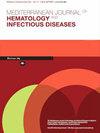对血小板减少的血液病患者进行支气管肺泡灌洗的安全性 - 一项回顾性队列研究
IF 2
4区 医学
Q3 HEMATOLOGY
Mediterranean Journal of Hematology and Infectious Diseases
Pub Date : 2024-01-01
DOI:10.4084/mjhid.2024.006
引用次数: 0
摘要
背景住院血液病患者经常需要进行支气管肺泡灌洗(BAL)。有关极重度血小板减少症(VST)患者潜在风险的证据不足。 方法 这项回顾性队列研究纳入了 2012-2021 年期间接受 BAL 的 VST(定义为血小板<20x103/μL)成人血液病住院患者。机械通气患者或已知有活动性出血的患者除外。主要结果包括导致 BAL 中止或主治医生认为严重的大出血、需要低流量氧气以外的任何呼吸支持或 24 小时内死亡。其他任何出血情况均作为次要结果记录在案。 结果 在纳入最终分析的 507 名患者中,281 名 VST 患者的血红蛋白较低(Md=0.3,p=0.003),凝血酶原时间较长(Md=0.7s,p=0.025),术前输注血小板的几率较高(RR 3.68,95%CI[2.86,4.相比之下,血小板≥20x103/μL的患者有3次(1.3%)事件(两次出血导致手术中止,一次需要无创通气)(P=0.219)。VST患者发生轻微、自发缓解出血的风险更高(RR=3.217,95%CI[0.919,11.262])(4.3% vs 1.3%,P=0.051)。未发现任何并发症与术前血小板、年龄、aPTT、PT、血液学状况或血小板输注有关。 结论 这些数据表明,即使血小板计数小于 20x103/μL,BAL 也是安全的。本文章由计算机程序翻译,如有差异,请以英文原文为准。
SAFETY OF BRONCHOALVEOLAR LAVAGE IN HEMATOLOGICAL PATIENTS WITH THROMBOCYTOPENIA – A RETROSPECTIVE COHORT STUDY
Background Hospitalized hematological patients often require bronchoalveolar lavage (BAL). Paucity of evidence exists as to the potential risks in patients with very-severe thrombocytopenia (VST). Methods This retrospective-cohort study included adult hematological in-patients with VST, defined as platelets<20x103/μL, undergoing BAL during 2012-2021. Mechanically-ventilated patients or those with known active bleeding were excluded. Primary outcomes included major bleeding halting the BAL or deemed significant by the treating physician, need for any respiratory support other than low flow O2 or death within 24 hours. Any other bleeding were recorded as secondary outcomes. Results Of the 507 patients included in the final analysis, the 281 patients with VST had lower hemoglobin (Md=0.3, p=0.003), longer prothrombin-time (Md=0.7s, p=0.025), higher chances of preprocedural platelet transfusion (RR 3.68, 95%CI[2.86,4.73]), and only one primary-outcome event (death of septic shock 21h postprocedurally) - compared with 3 (1.3%) events (two bleedings halting procedure and one need for non-invasive-ventilation) in patients with platelets ≥20x103/μL (p=0.219). Risk of minor, spontaneously resolved bleeding was higher (RR=3.217, 95%CI[0.919,11.262]) in patients with VST (4.3% vs 1.3%, p=0.051). No association was found between any of the complications recorded and preprocedural platelets, age, aPTT, PT, hematological status, or platelet transfusion. Conclusions This data suggests BAL to be safe even when platelet counts are <20x103/μL.
求助全文
通过发布文献求助,成功后即可免费获取论文全文。
去求助
来源期刊

Mediterranean Journal of Hematology and Infectious Diseases
Medicine-Hematology
CiteScore
4.20
自引率
6.20%
发文量
113
审稿时长
12 weeks
期刊介绍:
Reciprocal interdependence between infectious and hematologic diseases (malignant and non-malignant) is well known. This relationship is particularly evident in Mediterranean countries. Parasitosis as Malaria, Leishmaniosis, B Hookworms, Teniasis, very common in the southeast Mediterranean area, infect about a billion people and manifest prevalently with anemia so that they are usually diagnosed mostly by experienced hematologist on blood or bone marrow smear. On the other hand, infections are also a significant problem in patients affected by hematological malignancies. The blood is the primary vector of HIV infection, which otherwise manifest with symptoms related to a reduction in T lymphocytes. In turn, infections can favor the insurgency of hematological malignancies. The causative relationship between Epstein-Barr virus infection, Helicobacter pylori, hepatitis C virus, HIV and lymphoproliferative diseases is well known.
 求助内容:
求助内容: 应助结果提醒方式:
应助结果提醒方式:


